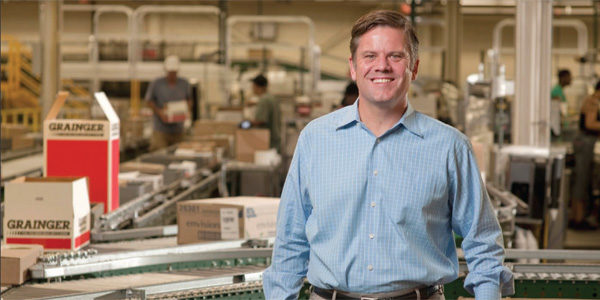Keeping track of all the moving parts: interview with D.G. Macpherson

A supply chain that moves over 1,000,000 items around the globe each year and supports worldwide sales of $7 billion annually demands organization, innovation, and a leader with the right background, skill set, and management style. For W.W. Grainger Inc., that person is D.G. Macpherson.
Macpherson, who joined Grainger in February 2008, heads up the company's global supply chain operations as senior vice president of the division. He is responsible for operations, including the performance of Grainger's distribution centers as well as its product offerings and availability. He also provides global planning, coordination, and specialized expertise to the supply chain organizations in all of Grainger's business units.
Macpherson came to Grainger from the Boston Consulting Group (BCG), where he was partner and managing director for six years. In that capacity, he served as a strategic consultant at Grainger and led BCG's relationship with Grainger. His guidance helped Grainger shape and execute many supply chain initiatives that have been foundational to the distributor's growth, including product availability improvements and product line expansion. Earlier in his career, he was an operations manager for Rain Bird Sprinkler Manufacturing Co. and a test engineer with the U.S. Air Force.
Macpherson holds a bachelor's degree from Stanford University and an M.B.A. from Northwestern University's Kellogg Graduate School of Management. He spoke recently with DC Velocity Group Editorial Director Mitch Mac Donald about his career path and his team's commitment to supply chain excellence.
Q: Tell us about Grainger and its mission.
A: Grainger is an industrial distribution business that has been around since the 1920s, and we have a Canadian operation that's even older than that. Grainger today is focused on making sure we provide customers with a very broad range of products to help them keep their facilities and operations up and running. Our reputation is based on providing terrific, very high-level service to our customers.
Q: What do you see as your mission as senior vice president of global supply chain operations?
A: We are a very large U.S. business that last year generated roughly $7 billion in sales. We've been around for a long time and we have international businesses, our Canadian business being by far the biggest of these. I am responsible for the global supply chain, which really supports all of those. My role is making sure that we have, to simplify things a bit, the right products in the right place at the right time for all of our businesses throughout the world. I spend a lot of time thinking about product management, inventory management, transportation, operations, global sourcing, and our relationships with suppliers.
The best way to describe the nature of our operations is that we have literally thousands of suppliers that we work with and that are very important to our efforts to make sure we provide great service to our customers. They provide us with hundreds of thousands of products, which we distribute to our customers through multiple channels. In the United States, in Canada, in most of our businesses, customers can walk into a local branch to get their product or they can use one of our catalogs or our website.
In the United States, for example, we have about 3,000 suppliers. We have 10 distribution centers, which are fairly large buildings. We carry over 400 brands of products in our DCs. We have over 300,000 transactions a day, so we have a lot of transactions in those buildings. Our objective every time we have a transaction is to get the order perfect. Our business is really based on our team members' understanding that objective.
Q: Given your extensive product line and the varied sales channels, you probably use a pretty broad mix of shipping modes, everything from parcel express to truckload, right?
A: Yes, we do. One thing that's interesting about our business is that we do many transactions, but they're typically $250 to $300 at a time, so customers are not ordering huge amounts in most cases. We are generally really working on their immediate needs, and those are typically small orders. For that reason, small parcels account for the biggest share of our shipping transactions, but we do use pretty much every mode of transportation.
Q: You've seen substantial growth with global initiatives. Could you touch a little bit on Grainger's global strategy?
A: We have expanded pretty rapidly. International is about 20 percent of our total mix. We have a very clear strategy to leverage our supply chain scale to expand in the Latin America region and in Asia. We have strong business in Mexico. We have strong business in Japan. We have fledgling businesses in China and India. From a supply chain perspective, I'd say we aim to follow the same principles we follow in our U.S. business, which is making sure you provide absolutely flawless service to customers, making sure your key members are wired to ensure absolutely flawless execution.
I think some things are different, though. For example, depending on the competitive side of the market you're in, the product range requirements may vary dramatically. Oftentimes, the product range in smaller countries is much narrower than in, say, Canada or the United States, so we have to think differently. Still, we want to make sure we have a better product offering, in many cases a broader product offering, than any of our competitors. What that equates to can be much narrower margins, so it can be a very different ballgame.
Q: Which of your skills do you believe serve you best as you go about the daily business of managing Grainger's global supply chain?
A: There are a couple of things that I think are important. One is making sure that we stay very focused on what delivers value for the customer. The other, I think, is just being comfortable working with multiple levels of our organization, multiple functions, and working and cross collaborating with the commercial side of the business. It is important to be able to go from discussions with sales and marketing and then translate the key points for my team, every level of my team, effectively. I think those are the things that are important—making sure you have a strategic focus that is based on customer value and then working with all levels of the organization to communicate that to all team members successfully.
Q: Put on a futurist's hat for a moment. What do you see as the next big thing in logistics and supply chain management?
A: Connectivity to our suppliers and collaboration with our suppliers that allows us to improve that part of our performance. Our suppliers do a great job of providing us with products of very high quality, but I think we can probably do things on the collaboration side with suppliers. For us, it is specific probably because we have got so many. We've got thousands of suppliers and some of them are very small businesses, some are very big businesses. The challenges of achieving transparency, visibility, and collaboration in ways that improve performance—I think that is really the area where we could probably improve the most.
Q: What advice would you give to a young person interested in a career in supply chain management?
A: There are two bits of advice I would give them. The first is make sure that you get out and understand customers, that you actually visit customers and develop a visceral understanding of what your customers need. I think you really need to get out there and touch and feel what the customer does.
The other thing is to think carefully about where they go. In some organizations, supply chain and operations are absolutely core to strategy and kind of one and the same. In others, they are not. I think you will get kind of a different level of interaction with core strategy and what the business does depending on where you go. Both can be great, but you need to think about it because it can have an influence on the overall business.
Related Articles

Copyright ©2024. All Rights ReservedDesign, CMS, Hosting & Web Development :: ePublishing